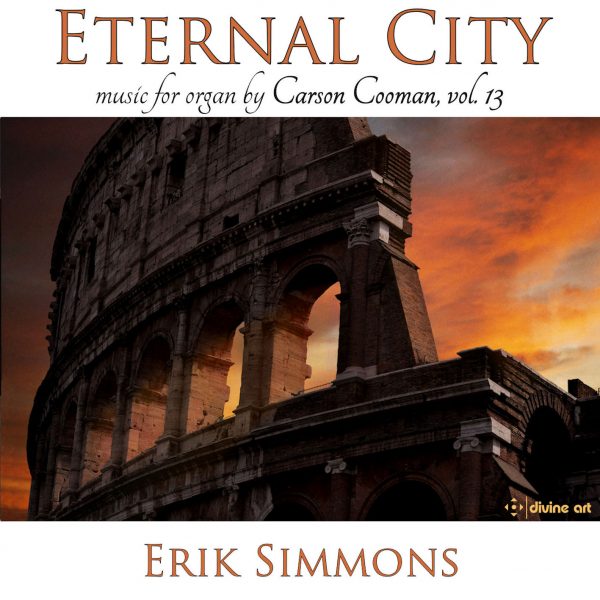Fanfare
I have now reviewed six CDs of Carson Cooman’s organ works in these pages, with a mixture of verdicts— thumbs up to Volumes 1, 5, 6, 7, 8, and thumbs down to volume 11, plus a mixed verdict on a disc of non-organ music. In a couple of the positive reviews, my approbation was mitigated by objections to the sound of the particular organ used. Here, in this newest release (titled Eternal City), I am happy to say that everything lines up in the plus column, as Cooman has selected some of his best pieces for inclusion here.
The disc opens with the three-movement Trilogy on B-A-C-H; as Cooman himself writes in his booklet notes, he chooses to employ that famous four-note motif (B flat-A-C-B in German musical notation) thematically and motivically rather than contrapuntally. The opening “March” has a quirky, rather impishly skipping earworm of a theme; the succeeding “Meditation” is broad and quiet; the closing “Fantasia,” my favorite movement of the three, is both energetic and imaginative in its free handling of its material. Eternal City, referencing a visit by the composer to Rome, consists of two movements, both of which rely on triplet motifs: “Mystic Prelude,” in which slow-moving, somewhat dissonant sustained chords alternate with a flowing line with a decidedly Renaissance music flavor to its contours, and a brief but spikily energetic “Fire Dance.” Whereas all the other pieces in this release date from 2017-18, the Three Voluntaries that come next are early works from 1999, composed for small (one or two manuals plus pedals) instruments. The first, Slow, sounds like a solemn passacaglia in 3/4 time; the succeeding brief Joyful and Moderate movements are more lively and upbeat in tone. Next come two one-movement works, a bold and energetic Introitus in D that adroitly manages to be multi-sectional within the compass of only 3:12, and a Rhapsody in A that at 8:35 is free-form and even more kaleidoscopic in its variety of tempos and colors, while yet also providing a fully satisfying unity of mood through its angular thematic material.
The three-movement Sonatina No. 5 opens with a “Fanfare” in which the influence of Messiaen is noticeably present. A following “Prayer” provides a suitably meditative, still, and serene interlude before the lively, dance-like “Toccata” brings the work to a sparkling close. Next comes Two Contrasts: The first, “Sharagan,” is named for “a style of monodic hymn in the Armenian Orthodox Church” and appropriately invokes a slightly exotic Middle Eastern ambience with a paradoxical combination of sinuousness and stillness; the second, “Madrigal,” alternates broad, declamatory chords with a hopping, puckish folk dance melody. Acclamatio derives its inspiration from a short ecclesiastical chant, “Christus vincit, Christus regnat, Christus imperat” (Christ conquers, Christ reigns, Christ commands). The piece employs repeated short fanfare-like outbursts and sharp dissonances to portray shouts of acclamation; this is the one selection on this disc that I did not care for, as its reiterations became monotonous. The recital closes with the most extended one-movement piece on offer (11:54), the Radegund Variations, which commemorates the life and work of a Thuringian princess (c. 520-587), who became one of the fives wives of the polygamous Frankish king Clotaire I or Chlothar (c. 497-561). She was renowned for her charity and piety, and after Clotaire had her brother murdered in order to seize his lands in an ongoing series of bloody dynastic struggles she fled, took refuge under the protection of the bishop of Noyen, founded a monastery, and devoted herself to caring for the infirm. She was reputed to have a miraculous gift for healing, and befriended the famous Christian poet Venantius Fortunatus (c. 530-600/609). These events are presented by a series of six variations, built upon the theme “Radegunde-Hymnus” from the oratorio Radegunde by Cooman’s friend, the German organist-composer Andreas Willscher. (Back in 41:4,I favorably reviewed a CD of Cooman playing two of Willscher’s organ symphonies.) The work is by turns dramatic and reflective, and always full of interest. Like the disc of Cooman’s Christmas organ music that I review in this issue, the instrument employed here—as usual in this series, via the Hauptwerk system—is the Sonnenorgel (“sun organ,” named for the solar decorations on the organ case) of the Pfarrkirche St. Peter and Paul in Gorlitz, on the southeastern border of Germany with Poland. The choice is a happy one that I hope will continue; built between 1997 and 2006, it retains many features of traditional German organs but also has a sufficient number of modem ones to avoid sounding anachronistic in modem repertoire such as this. As always, Erik Simmons is the perfect executant for his friend’s music. Full specifications for the instrument are provided, along with the composer’s notes on his works (including his dedicatees for each piece, a characteristic and nice touch) and bios with photos. This is one of the stronger entries in the continuing series of discs devoted to Cooman’s organ music; heartily recommended.
@divineartrecordingsgroup
A First Inversion Company
Registered Office:
176-178 Pontefract Road, Cudworth, Barnsley S72 8BE
+44 1226 596703
Fort Worth, TX 76110
+1.682.233.4978
We noticed you're visiting from Latvia. We've updated our prices to Euro for your shopping convenience. Use Pound sterling instead. Dismiss












